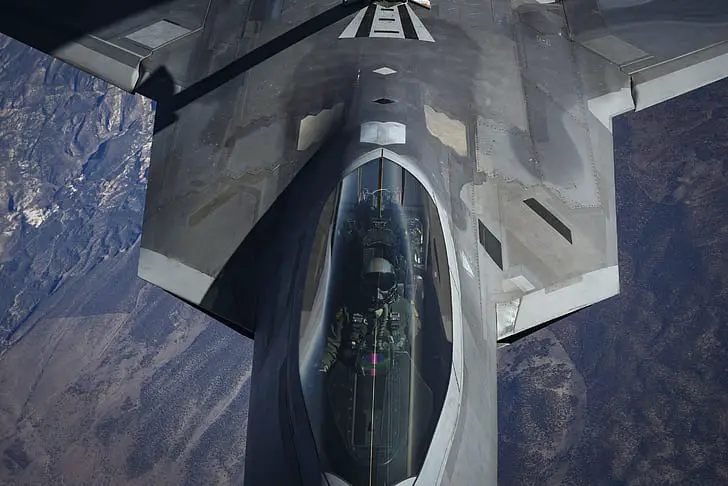The U.S. Air Force is planning the modernisation of the F-22 Raptor fighters to significantly expand its ability to detect targets. The main task is to equip the F-22 with such sensors that will allow 100% detection of the enemy aircraft before it can visually see the F-22. At the same time, it is noted that the technological level of the updated avionics will be such that there will be no difficulties when detecting stealth.
IRST
A newly released document under the “Small Business Innovation and Research and Development” project shows that the U.S. plans to integrate the F-22’s with an infrared search and track (IRST) system to achieve the objectives. The report mentions that the initial version of the F-22 fighter featured an advanced IRST system, a rare technology in Western fighter designs at the time. However, when the F-22 aircraft entered production, it was not equipped with the IRST system. The absence of the IRST system is just one of many features the F-22 lost, including side-looking radar arrays mounted on either side of the nose, which fell prey to budget cuts early on in the program.
The report says the IRST system would allow F-22 fighter jets to detect engaging targets without turning on their onboard radar, providing “another level of protection.” The advanced IRST systems can detect targets that radar cannot see, such as stealth fighter jets, drones, bombers, and cruise missiles. These are the types of threats that USAF F-22’s might encounter in a confrontation with China or Russia.
It is unknown if the interior space previously reserved for the IRST system and the associated cooling capacity are still adequate or if the system is to be installed on a pod outside without impacting the stealth aspect. A low-observable IRST window for the F-22 was tested for stealth and durability in 2016.
Pilot – Drone coordination
It is also planned to equip the F-22 Raptor fighters with systems that would allow pilots to effectively exchange data with drones with which a joint operation is carried out. To do this, it is planned to modernise the Thales Scorpion helmet. The pilot flying the F-22 will receive information from the UAV on the “visor” of such a helmet, which, as stated, will allow him to make an operational decision in the format of the operation being carried out.

The upgrade project
The U.S. Air Force has allocated a round sum of $10 billion to modernise its F-22 Raptor fleet. The Pentagon hopes the work should be completed by the fall of 2031.
According to the U.S. Department of Defense, the contract will cover services, including updates, improvements and technical support for the Raptor. Lockheed Martin will also provide logistics services and upgrade kits.
This contract was the final stage of the modernisation of this aircraft.
Does the U.S. plan to retire F-22?
As per earlier information, there are 187 F-22 Raptors in service, and they will start to get retired by around the year 2030. According to the U.S. military, in the 2030s, the aircraft will not perform combat missions that Washington predicts based on an analysis of future threats.
The Chief of Staff of the U.S. Air Force, Charles Q. Brown, Jr., had said that Washington was striving to rationalise the fighter fleet to four models. Under the Next Generation Air Dominance (NGAD) program, the air force will be rationalised to just four types of aircraft, including the Lockheed Martin F-35 multifunctional fighter, Boeing F-15EX, Lockheed F-16 and a sixth-generation fighter. Currently, the U.S. military is equipped with seven types of fighters.
It’s not yet clear how close the NGAD program is to rollout, but Pentagon officials say it’s ahead of schedule.
It is now evident that in the event of a shift in the timing of the program’s implementation, the Americans will have to keep the F-22 in service.
There are also advantages with F-35 that F-22 does not have. F-22 can carry six AIM-120C AMRAAMs and two AIM-9 missiles in its internal weapons bays, while the F-35 can only carry four AMRAAMs inside its bay while maintaining low radar visibility.
However, the F-35 is newer, more flexible and easier to maintain, has a longer service life ahead of it than the F-22, and new weaponry is coming through its Block 4 modernisation program. And importantly, the F-35 is easier to upgrade than the F-22.
In addition, the U.S. Air Force will operate F-35s in greater numbers than F-22’s. The USAF had 283 F-35s as per official sources in March 2021. But the Pentagon officials had said last year that the FY22 budget would request targeted upgrades to the F-22’s sensor capabilities and funding for new airborne weapons that can be used on the F-35.
F-22 Raptor
The F-22 Raptor is a fifth-generation multirole fighter developed in 1997 by Lockheed Martin, Boeing and General Dynamics to replace the fourth-generation F -15 Eagle fighter. In 2005, the F-22 entered service with the U.S. Air Force. During serial production from 1997 to 2011, 187 units were produced. Due to the reduction in the order of the U.S. Department of Defense from 384 to 188 units and the ban on the export of the F-22, the Raptor became the most expensive serial fighter in the world – $ 146.2 million per aircraft.
